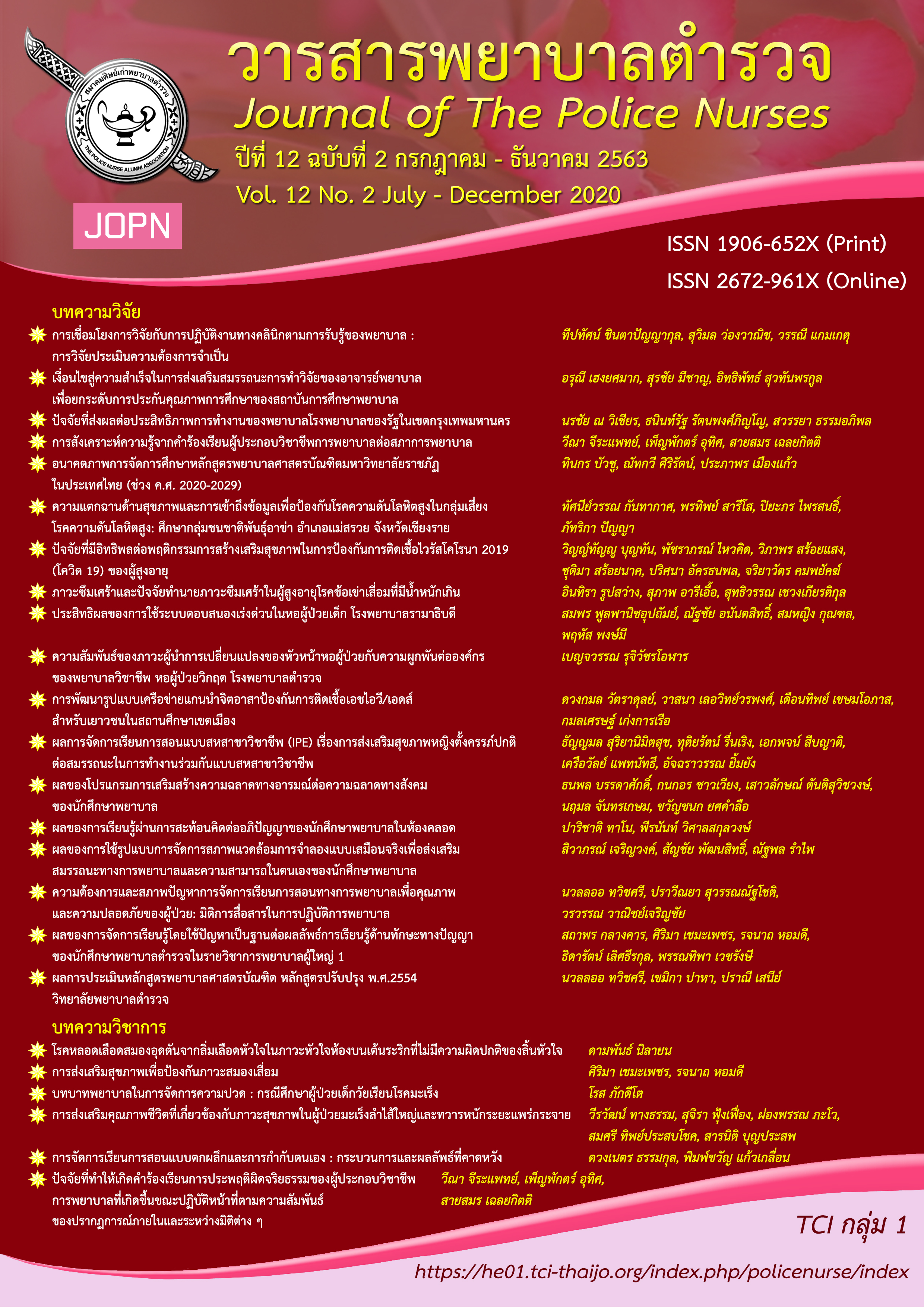ประสิทธิผลของการใช้ระบบตอบสนองเร่งด่วนในหอผู้ป่วยเด็ก โรงพยาบาลรามาธิบดี
คำสำคัญ:
ระบบตอบสนองเร่งด่วน, หอผู้ป่วยเด็ก, เครื่องมือประเมินและเฝ้าติดตามอาการผู้ป่วยเด็กที่เริ่มมีอาการทรุดลงบทคัดย่อ
การวิจัยครั้งนี้เป็นการศึกษาเชิงสืบย้อนมีวัตถุประสงค์เพื่อศึกษาระดับความรุนแรงของผู้ป่วยเด็กโดยใช้เครื่องมือประเมินและเฝ้าติดตามอาการผู้ป่วยเด็กที่เริ่มมีอาการทรุดลง และเปรียบเทียบจำนวนการย้ายเข้าหอผู้ป่วยวิกฤตโดยไม่ได้วางแผน จำนวนการช่วยฟื้นคืนชีพผู้ป่วย และจำนวนการเสียชีวิต ก่อนและหลังการใช้ระบบตอบสนองเร่งด่วนรามาธิบดีสำหรับผู้ป่วยเด็ก ตัวอย่าง คือ ผู้ป่วยที่มีอายุตั้งแต่ 1 เดือนขึ้นไป จนถึง อายุ 15 ปี เข้ารับการรักษาในหอผู้ป่วยเด็ก โรงพยาบาลรามาธิบดี แบ่งออกเป็น 2 กลุ่ม คือ กลุ่มผู้ป่วยเด็กก่อนมีระบบตอบสนองเร่งด่วนจำนวน 1,509 คน และกลุ่มผู้ป่วยเด็กหลังมีระบบตอบสนองเร่งด่วน จำนวน 1,524 คน เครื่องมือวิจัย ประกอบด้วย 1) แนวทางการเฝ้าระวังและการตอบสนองต่อผู้ป่วยเด็กที่มีแนวโน้มอาการทรุดลง และ 2) เครื่องมือประเมินและเฝ้าติดตามอาการผู้ป่วยเด็กที่เริ่มมีอาการทรุดลง โดยเป็นเครื่องมือประเมินที่แบ่งเป็น 4 กลุ่มช่วงอายุ มีค่าดัชนีความตรงเชิงเนื้อหาเท่ากับ 1.00 และมีค่าความเที่ยงที่ได้จากการประเมินความสอดคล้องระหว่างผู้ประเมินเท่ากับ .92, .94, .90 และ .95 ตามลำดับ วิเคราะห์ข้อมูลโดยใช้สถิติเชิงพรรณนาและMann-Whitney U test
ผลการวิจัย พบว่า 1) ระดับความรุนแรงของผู้ป่วยเด็กส่วนใหญ่อยู่ในระดับความเสี่ยงต่ำ และ 2) ผลการเปรียบเทียบก่อนและหลังการใช้ระบบตอบสนองเร่งด่วนรามาธิบดีสำหรับผู้ป่วยเด็ก พบว่า จำนวนผู้ป่วยที่ย้ายเข้าหอผู้ป่วยวิกฤตโดยไม่ได้วางแผนลดลงอย่างมีนัยสำคัญทางสถิติที่ระดับ .05 ส่วนจำนวนการช่วยฟื้นคืนชีพและจำนวนการเสียชีวิตของผู้ป่วยแตกต่างกันอย่างไม่มีนัยสำคัญทางสถิติ
Downloads
เอกสารอ้างอิง
Agulnik, A., Mora Robles, L. N., Forbes, P. W., Soberanis Vasquez, D. J., Mack, R., Antillon-Klussmann, F., . . . Rodriguez‐Galindo, C. (2017). Improved outcomes after successful implementation of a pediatric early warning system (PEWS) in a resource-limited pediatric oncology hospital. Cancer, 123(15), 2965-2974. doi:10.1002/cncr.30664
Andersen, L. W., Kim, W. Y., Chase, M., Mortensen, S. J., Moskowitz, A., Novack, V., . . . Donnino, M. W. (2016). The prevalence and significance of abnormal vital signs prior to in-hospital cardiac arrest. Resuscitation, 98, 112-117. https://doi.org/10.1016/j.resuscitation.2015.08.016
Cater, D. T., Tori, A. J., Moser, E. A. S., & Rowan, C. M. (2018). Modification and assessment of the bedside pediatric early warning score in the pediatric allogeneic hematopoietic cell transplant population. Pediatric critical care medicine, 19(5), 483-488. doi:10.1097/PCC.0000 000000001521
Donabedian, A. (2003). An introduction to quality assurance in health care. New York, NY: Oxford University Press.
Fuijkschot, J., Vernhout, B., Lemson, J., Draaisma, J. M., & Loeffen, J. L. (2015). Validation of a paediatric early warning score: First results and implications of usage. European journal of pediatrics, 174(1), 15-21. doi:10.1007/s00431-014-2357-8
Lambert, V., Matthews, A., MacDonell, R., & Fitzsimons J. (2017). Paediatric early warning systems for detecting and responding to clinical deterioration in children: A systematic review. British Medical Journal, 7(3), e014497. doi:10.1136/bmjopen-2016-014497
Mason, B. W., Edwards, E. D., Oliver, A., & Powell, C. V. E. (2018). Cohort study to test the predictability of the NHS Institute for Innovation and Improvement Paediatric Early Warning System. Archives of Disease Childhood, 101(6), 552-555. doi:10.1136/archdischild-2015-308465
Ministry of Public Health. (2020). Public Health Statistics A.D. 2019. Nonthaburi: Strategy and Planning Division.
Parshuram, C. S., Dryden-Palmer, K., Farrell, C., Gottesman, R., Gray, M., Hutchison, J. S., . . . Moga, M. A. (2018). Effect of a pediatric early warning system on all-cause mortality in hospitalized pediatric patients: The EPOCH randomized clinical trial. The Journal of the American Medical Association, 319(10), 1002–1012. doi:10.1001/jama.2018.0948
Seiger, N., Maconochie, I., Oostenbrink, R., & Moll, H. A. (2013). Validity of different pediatric early warning scores in the emergency department. Pediatrics, 132(4), 1–10.
The Healthcare Accreditation Institute. (2019). Hospital and healthcare standard (4th ed.). Bangkok: One D books.
ดาวน์โหลด
เผยแพร่แล้ว
รูปแบบการอ้างอิง
ฉบับ
ประเภทบทความ
สัญญาอนุญาต
ผลงานที่ได้ตีพิมพ์แล้วจะเป็นลิขสิทธิ์ของวารสารพยาบาลตำรวจ















